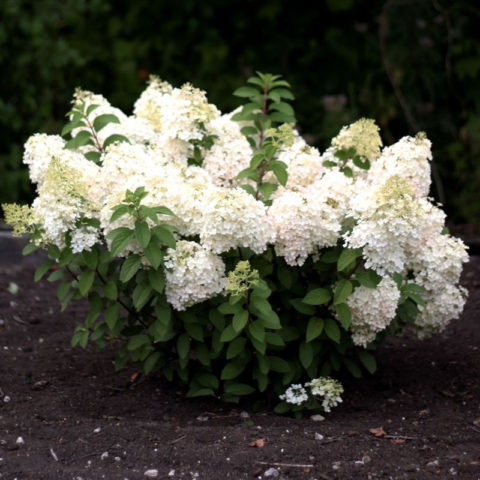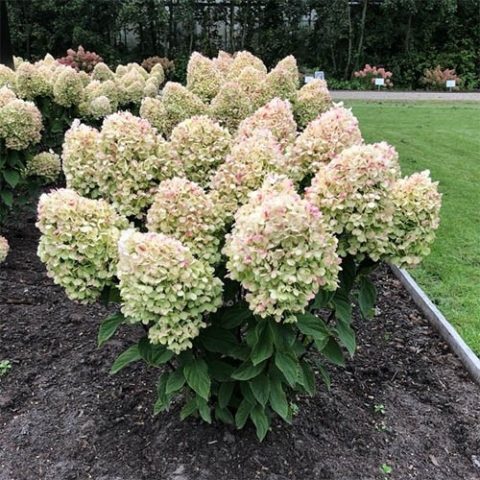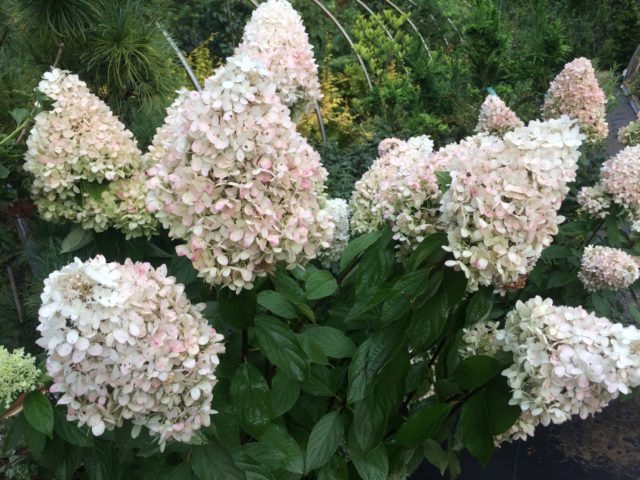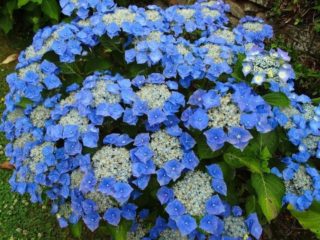Content
Hydrangea Summer Snow is a short perennial shrub with a spreading crown and attractive large white inflorescences. With proper care, they appear during July, August, September and even early October. Due to its high decorative value, Summer Snow is often used to decorate a country garden and a country house. The variety is distinguished by its high winter hardiness, which makes it possible to grow shrubs in most regions of Russia.
Description of hydrangea Summer Snow
Summer Snow is a type of panicle hydrangea with snow-white flowers, collected in lush inflorescences in the form of large panicles (length up to 35 cm). Differs in a long flowering duration - from mid-July to early October. Moreover, the first inflorescences appear already in the year of planting the seedling.
Hydrangea Summer Snow is a lush, spreading shrub with a dense globular crown (mostly up to 80-150 cm in height). With proper care, it grows up to 3 m, resembling a beautiful flowering tree. The leaves are large, with a pointed end, have a dark green color and a matte surface. Thanks to this, the inflorescences resemble the snow that has covered the bush. Therefore, the name of hydrangea is translated as "summer snow".

Hydrangea Summer Snow has luxurious white flowers, which are collected in large panicle inflorescences
Hydrangea paniculata Summer Snow in landscape design
Panicle hydrangea Hydrangea Paniculata Summer Snow will decorate a garden, flower garden, lawn in front of the house. Since the bush grows quite sprawling and tall, the variety is more often used in single plantings. Along with this, there are other applications. For example, you can use it:
- in mixborders with other colors;
- in compositions with perennial herbaceous plants;
- to form a hedge (in this case, the planting interval between adjacent seedlings is reduced to 80 cm).

Hydrangea Summer Snow looks good both against the backdrop of the lawn and on the "bare" ground
Winter hardiness of hydrangea paniculata Living Summer Snow
Summer Snow belongs to varieties with good winter hardiness. There is evidence that it can withstand winter frosts down to -35 degrees. Therefore, it is suitable for growing in almost all regions of Russia, including:
- Central part;
- Ural;
- South of Siberia;
- Far East.
Planting and caring for Summer Snow hydrangea
The bush is purchased in nurseries in order to plant it in early spring (it is possible in April, after the snow melts). The only exceptions are the Krasnodar Territory, the North Caucasus and other southern regions.Here Summer Snow, like other hydrangeas, is allowed to be planted in the fall (approximately in the second half of October).
Selection and preparation of the landing site
To choose the best place, you need to take into account several points:
- Hydrangea Summer Snow loves well-lit heights on which precipitation does not stagnate. If the groundwater comes too close to the surface, the soil should be drained with small stones.
- A slight shade from buildings, neighboring bushes is allowed, and in the south it is even desirable.
- If possible, the site should be protected from strong drafts and wind - it is optimal to plant the Summer Snow hydrangea next to the house or other buildings.
- Avoid planting a flower next to trees as they absorb a lot of moisture.
Before planting Summer Snow hydrangeas, the site is cleared of debris and dug up. The optimum soil response is moderately acidic, with a pH of about 5.0. A neutral reaction is allowed, but on a strongly alkaline soil, Summer Love, like other varieties of hydrangea, will grow very poorly. Therefore, you can pre-neutralize, for example, 9% vinegar (half a glass for 10 liters of water).

In open areas, Summer Snow hydrangea looks especially beautiful
Landing rules
Before planting, it is necessary to prepare a fertile mixture of the following components:
- sheet land (2 parts);
- humus (2 parts);
- peat (1 part);
- sand (1 part).
The planting process itself is simple:
- In the prepared area, holes are dug with a depth and diameter of 30 cm.
- Root the seedling and sprinkle it with the mixture so that the root collar remains on the surface.
- Give 1-2 buckets of water.
Watering and feeding
Hydrangea of this species has a high need for water. Watering should be done regularly, so that the topsoil does not dry out and, moreover, does not crack. The standard volume of water is 1 bucket per seedling and 2-3 per adult bush. Watering once a week in the absence of rainfall, and in drought - a little more often. If it rains, they are guided by soil moisture.
Top dressing is applied regularly (at least 3-4 times per season) to ensure lush and long flowering:
- In early spring (March-April), a complex mineral fertilizer is given.
- At the beginning of spring, you can sprinkle with slurry once diluted with water 10 times.
- At the stage of bud formation, it is useful to feed with superphosphates (70 g per 1 m2) and potassium sulfate (40 g per 1 m2).
- The last 2 dressings are applied in July and August: the composition is the same (potassium and phosphates).

Summer Snow will need regular watering and feeding for lush flowering.
Pruning panicle hydrangea Summer Snow
The bush needs annual pruning, which is best done in early spring, before the buds begin to bloom (optimally at the time of their swelling). Use pruning shears or garden shears for cutting. The basic rules are:
- All dead and damaged shoots are removed.
- Well-developed branches shorten significantly, leaving 3 buds.
- Old peduncles are removed completely (they give flowers for 2 years in a row).
Preparing for winter
Summer Snow is highly frost-resistant, so it does not need a special shelter. However, in the fall, it is advisable to lay out a layer of mulch from foliage, needles, peat, sawdust up to 6-7 cm and spud the bush (15-20 cm) so that it survives the winter safely. If extreme frost below -30 degrees is possible in the region, it is advisable to cover the plant with spandbond, burlap or a special cover.
Reproduction
Hydrangea is bred:
- seeds;
- layering;
- vaccination;
- dividing the bush.
The simplest method is considered to be propagation by green cuttings. The instruction is as follows:
- Cut the top shoots with 2-3 pairs of leaves.
- Remove the upper leaves and cut the lower ones in half.
- Soak overnight in a root stimulant.
- Plant in moist sand and grow under glass for 1-1.5 months.
- After the appearance of several pairs of leaves, transplant into a pot and send to winter at a temperature of 14-16 degrees.
- In the summer, transplant to a permanent place.

Summer Snow hydrangea cuttings can root both in wet sand and in a glass of water
Diseases and pests
Summer Snow is quite resistant to diseases and pests. But periodically, the bush can infect fungal infections:
- powdery mildew;
- gray rot;
- rust.
Also, various pests are often parasitized on foliage and roots:
- aphid;
- spider mite;
- Chafer;
- scoop.
To combat them, it is recommended to use effective fungicides (Bordeaux liquid, "Skor", "Maxim") and insecticides ("Biotlin", "Green soap", "Aktara"). Preventive treatment is recommended in April.
Conclusion
Hydrangea Summer Snow is a rather unpretentious shrub that takes root well both in the middle lane and in the South, and beyond the Urals. If you regularly water and feed the plant, as well as cut off unnecessary branches, the hydrangea will bloom for a very long time. Therefore, Summer Snow will surely please all flower growers and will be able to decorate more than one garden.








